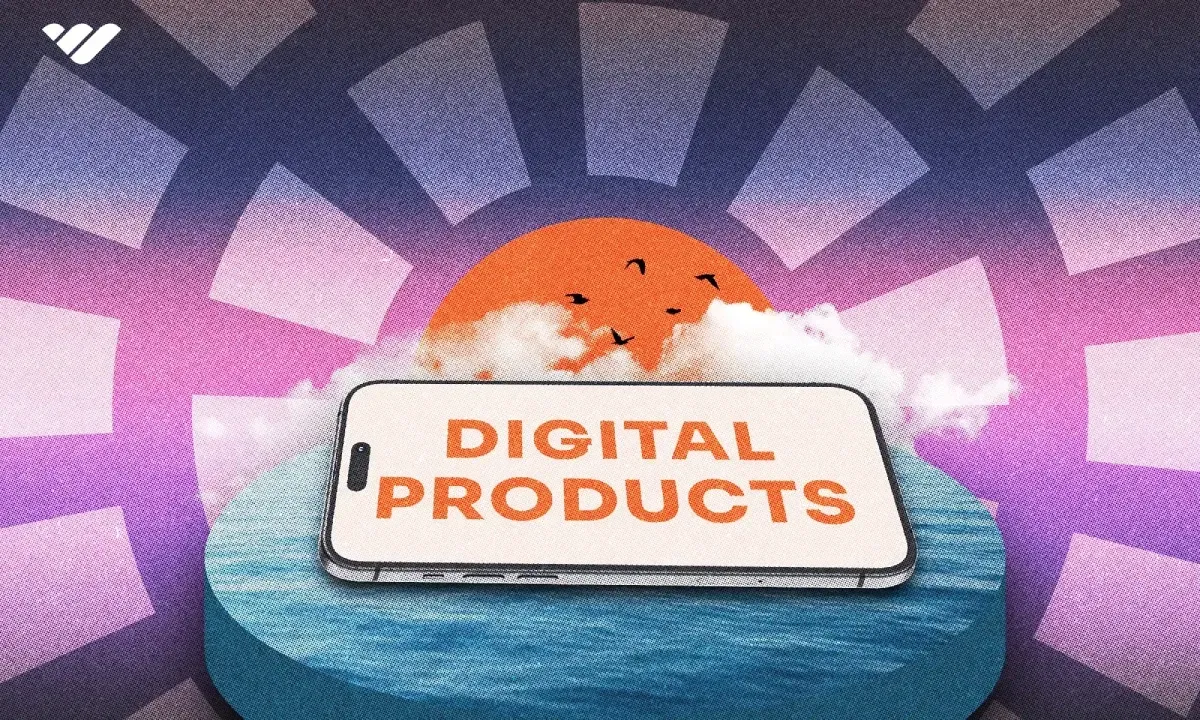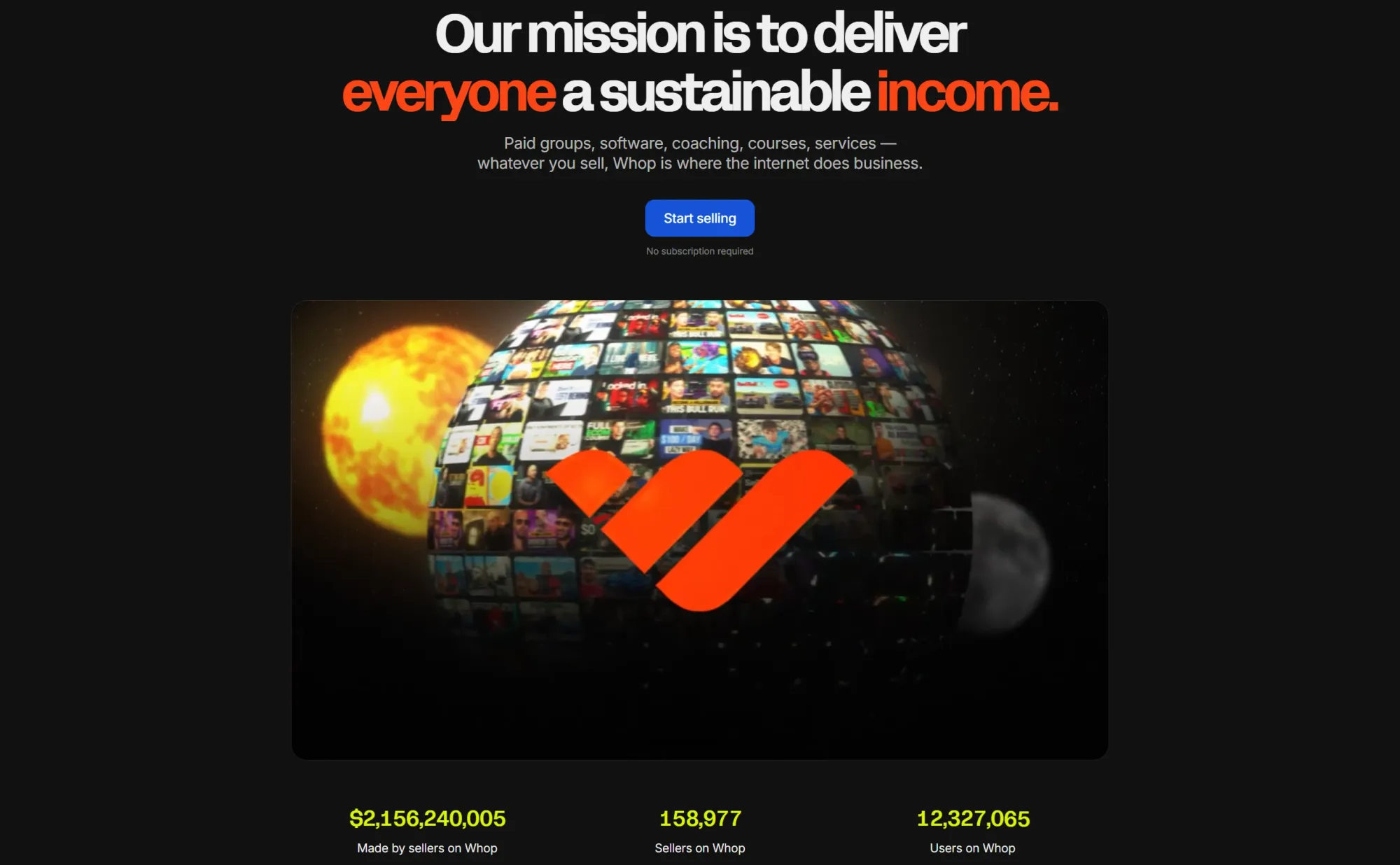How do you market digital products? Find out in this guide, complete with steps to take before you start marketing, and 12 strategies to grow your digital product sales.
Key takeaways
- Digital product sellers access unlimited global revenue streams with minimal overhead costs.
- Businesses must understand their ideal customer profile before launching any marketing campaigns.
- The rule of 7 requires customers see brands seven times before purchasing.
- Price anchoring with tiered options makes products accessible to wider audiences.
- Social proof influences over 80% of Americans in their purchasing decisions.
Selling digital products gives you access to a worldwide audience, with minimal overheads. As a result, if your product gains traction, you have an almost unlimited revenue stream.
However, the challenge lies in getting your product noticed in a highly competitive marketplace. In this guide, we'll explore some of the most useful marketing strategies for digital entrepreneurs.
How to sell digital products

There are quite a few elements that go into successfully selling digital products:
Firstly, you need to create the digital product and make sure it's polished and appealing enough for people to want to spend money on it. If you like writing blog posts or creating short videos for social media, that's a good start, but when you're planning to sell ebooks or instructional videos you'll need to think about covers, indexes, chapter markers, and other little details that add a professional touch.
Next, you'll need a platform to sell the product on. That could be your own social profiles or website, or something like a whop. You'll also need a way of taking payment and fulfilling the orders, ideally using some form of automated system so you can scale up your operations without having to spend endless hours manually processing orders.
Finally, you need to make people aware that your product exists and that it's useful for them. That's where marketing comes in.
What is digital product marketing?
Digital product marketing is the process of making people aware of your products, what they are, and why they should buy them. When most people think of marketing, they think of running paid search or social media ads, and while that's one element of marketing, there are numerous other things you can do that can have just as big, or an even bigger, impact on your sales.
If you're new to digital product sales, it's normal to feel like you've got no idea where to start with a marketing campaign. So let's break down the key components of a successful marketing strategy:
The first steps for marketing your digital products

To market your products effectively, you need to understand your audience and their needs before you jump into your marketing strategies. Otherwise, you could be marketing to the entirely wrong audience, wasting your time (and money!) on people who will not convert into customers.
So, before you jump into your marketing campaign,
Create your ideal customer profile
Your ideal customer is the sort of person who is most likely to benefit from your product and be the most lucrative for your business. Think about who your product serves, and why they'd want to buy it. Make a profile including their demographics (age, sex, location), interests, motivations, and pain points. These are all things you can use in your marketing content.
Undertake research
Now you have a customer in mind, you can run surveys or focus groups with people from those demographics. Use this opportunity to refine the customer profile, and also address any misconceptions you might have had about the motivations of your customers. Focus groups can help you improve your products too.
Research your competitors
Look at other products and services out there that serve a similar audience to you. Also, consider things outside of your niche that might be competing for your ideal customer's time and money. What is it about those products that appeals to your ideal customer? How is your product different from your competitors', and what makes your product better?
Bench mark your digital products
Testing is an important part of marketing. If you've already gone live with your online store or courses, make notes about what you're doing to promote the products at this stage. Measure some key performance indicators (KPIs) such as website visits or social media post views, engagement, clickthroughs, cart abandonment rates and sales.
Change one thing at a time, and if your chosen platform supports A/B testing, use those tools to compare the performance of different marketing creatives.
Armed with a great product and all of the information above, you're ready to start designing and running your marketing campaign.
12 ways to market your digital product

Try these ideas to raise awareness and interest in your products.
Run a pre-launch campaign
If you have a new product to sell, start generating some buzz with a pre-launch campaign. Post previews of the content, run a countdown to the launch, and offer pre-order bonuses to encourage people to place an order. Send out review copies to prominent bloggers or community leaders so they can share their thoughts with their audiences.
Solidify your SEO strategy
This tip doesn't apply so much to social media influencers and marketers, but if you have a blog or website you use to share your products, make sure the SEO is on point. Review your website's title and meta tags, as well as the ALT tags on your images. Work with other website owners serving your niche to generate some high-quality incoming links.
It can take a while for search engines to notice SEO improvements on your website, so the sooner you get to work on updating your site, the better.
Create an email marketing strategy
Email may be an older form of communication compared to social media, but it's still an essential one for businesses. Because emails can be longer than a social media post they can include more content, making them a good way to provide value and build trust with your target audience.
If you haven't already, start collecting the email addresses of current and prospective customers and building a marketing list.
Partner with influencers, bloggers, and brands
Advertising can build awareness, but having bloggers, influencers and other brands promote your products is more likely to create conversions. Influencers have that name because that's exactly what they do. They influence their followers to buy or use the brands they talk about. So, having an influencer on your side can work wonders for your sales.
Launch an online challenge
You may have seen other brands run online challenges where they ask people to perform a series of actions to earn entries into a prize draw or unlock access to a download. Prize-focused challenge funnels can take place over days or even weeks, making them a good option to run as part of a pre-launch campaign. Challenge participants post, share, and like content, helping increase its visibility to their friends and followers.
Get in front of the media
Don't underestimate the power of the media. Many websites use press release wires to get content ideas, so writing a press release and sending it to as many services as possible could earn you some coverage in publications you might not think to contact yourself. Contact outlets to offer interviews, and look out for opportunities to speak as an expert on your topic.
Gather and share social proof
Gather testimonials, case studies, and positive stories or social media posts from satisfied customers. Share these on your website or social media pages, and tag the individuals who made the initial post. Social proof is an incredibly powerful marketing tool. More than 80% of Americans say they're influenced by recommendations for products, and if you can show that there are real consumers out there who love what you have to offer, that's going to reassure those people your product is good.
Join an online marketplace
Joining an online marketplace helps increase your product's visibility to one of the most important groups of prospects - those with strong purchase intent. When someone goes to an online store and starts searching for a specific type of product, there's a high chance they either plan to buy today or very soon.
Those shoppers may not have heard of your product yet, but if they see your listing and it looks professional, with a good header image and lots of positive reviews, there's a good chance they'll consider buying it.
Content marketing funnel
The rule of 7 says that the average shopper needs to see a brand at least 7 times before they make a purchase. This rule was created in the 1930s, but it still holds true today. Technology may have evolved, but our brains still work the same way.
Content marketing funnels help you stay in touch with customers, taking them from that initial awareness stage through to making their first purchase, and hopefully becoming a repeat customer. Use landing pages, free gifts, short courses, and email marketing lists as part of your funnel to build a relationship with your target audience.
Host or join a webinar
Email marketing is inexpensive to produce and scales well, but it lacks the human touch. Some consumers respond better to more personal experiences. Hosting or joining a live webinar lets you communicate with your target audience face-to-face, in real-time. Use the webinar as a chance to share your knowledge, so the attendees feel like they've gained something valuable from the experience.
Webinars are particularly useful for those who are selling higher-value products or services. The larger the purchase, the more important it is for customers to feel a personal connection with the brand or seller. Use your webinars to answer questions, collect feedback, and build those relationships.
Offer multiple price points and payment options
Price anchoring is a technique salespeople use to influence customer behavior, and using tiered pricing is a form of price anchoring. By offering three price points - for example basic, standard, and luxury, you make your product accessible to a wider audience. The existence of an expensive luxury tier with some value-adds on top of the core product makes the standard tier seem like good value for money. The basic tier helps you secure some sales from people who really want your product, but can't afford the standard price.
A small percentage of your customers will choose to buy the luxury tier. These are people who have the money to do so and are enthusiastic about what you're offering. Take good care of these customers, and they'll probably come back to buy your next product too.
If possible, offer multiple payment options, including cards, PayPal, and any country-specific payment processors. If your products cost more than a few dollars, consider offering subscription/installment options as well as one-time payments.
Create or join a membership site
Membership sites can be an income stream in their own right, but they're also useful marketing tools. People who join membership sites become part of an exclusive club and feel an affinity with what the club is promoting. You can use this to your advantage to promote your product to a ready-made audience of prospective customers.
What is the best way to market digital products?
The list above is just a few of the ways you can market digital products. There's no single "best marketing technique" - you're more likely to have success if you combine several of the above options.
For example, make a marketing funnel that starts by building a strong following on social media. Then, promote your other marketing strategies to your audience 0 link them to your SEO-powered blog, invite them to your webinar, partner with influencers, host an online challenge, and ask your followers to sign up to your newsletter. You can repurpose content across all of these avenues and share social proof on your sites.
If you're a small business owner, you might not have time to implement all of the above suggested marketing strategies, but try to do as many as you can. Consider using a platform such as Whop to save you time and streamline your marketing efforts.
Marketing and selling digital products with Whop

We've touched on some of Whop's features throughout this guide. Whop is a social commerce platform with lots of useful features for content creators.
Marketing products via Whop is a simple process. Simply sign up to start selling, and then create your first whop. A whop is an online hub where you can sell and manage your digital products, including ebooks, videos, apps and more. Whop even has its own course creator so you can create polished, intuitive and media-rich courses on the platform.
The best part - not only can you sell your digital products, but you can create a community around them. With a Chat app for conversation, Forums app for Q and A, and Video app for calls/webinars, your community can thrive inside of your whop.
Once you've got your first product up and ready to go, you can start taking advantage of Whop's marketing features, including:
- Create Marketing Content: You can build up a nice database of blog and forum content, and if that content is set to be public rather than members only, it will be indexed by the search engines. This gives you the benefit of having your content on a domain with strong SEO ratings, so you're not starting from scratch with your search marketing.
- Host Webinars: No more struggling with confusing video conferencing platforms. The Whop Video app includes conferencing features that work out of the box.
- Social Proof: Review scores and comments are shown automatically on your Whop storefront, so as long as you're keeping your customers happy, you're building up a set of social proof from day one.
- Pricing Features: You have the option of using Whop as your Merchant of Record, or using a third-party payment processor. Whop lets you sell products with one-time payments, subscriptions, or Buy Now, Pay Later. It's up to you which of these features you use, depending on the demographics you're targeting.
- Online Challenges: The chat and other social features of your whop are ideal for running challenges. Once the challenge is complete you can use the Giveaways app to award prizes. Adding new features to your whop is as simple as activating their respective apps in the admin panel. There's no coding or complex configuration work required.
- Marketplace: In addition to selling products through the your own whop, you have the option to apply to join the Whop marketplace. This is a rapidly growing marketplace full of products from sellers that have been vetted by the Whop team. The marketplace sees substantial traffic from prospective customers, giving you increased reach to an entirely new audience.
Getting started with Whop is easy and you can use it as your primary marketing platform, or embed products from Whop into an existing website. There are no fees for joining Whop, the platform only makes money when you sell a product. All you pay is a 2.7% + $0.30 commission on any sales made, and for that, you get an all-in-one sales and community platform with powerful marketing features.
Start growing your digital product sales today

Whatever stage of your digital marketing journey you're at, from creating and marketing your first products to growing an online empire, Whop can help.
Join the growing number of creators on Whop to build your digital business.



